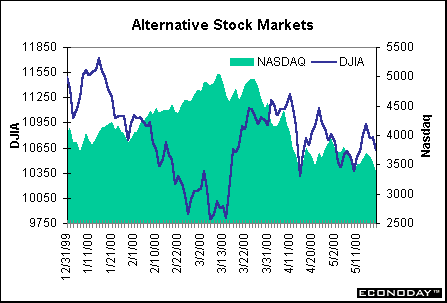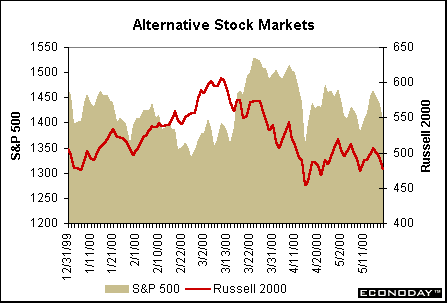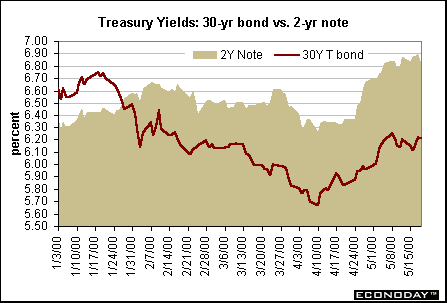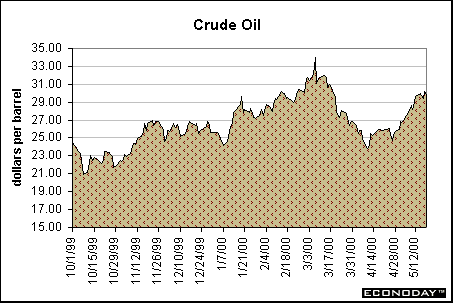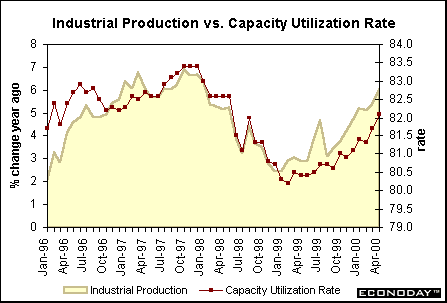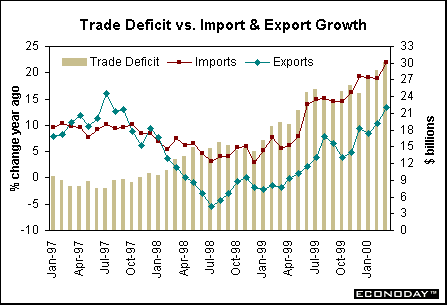| |||||||||||||||||||||||||||||||||||
| Previous Articles |
|
50
basis points now, more to follow? While market participants were generally expecting the Fed to raise the funds rate target more aggressively than they had in the past year (five 25 basis point hikes over nine months), the action should have been more bearish for the markets. In addition to the rate hike, the Fed said in its announcement that "increases in demand have remained in excess of even the rapid pace of productivity-driven gains in potential supply, exerting continued pressure on resources. The Committee is concerned that this disparity in the growth of demand and potential supply will continue, which could foster inflationary imbalances that would undermine the economyís outstanding performance Ö The Committee believes the risks are weighted mainly toward conditions that may generate heightened inflation pressures in the foreseeable future." The statement was quite hawkish and suggests that the Fed is prepared to continue this aggressive policy over the next few months. The question, of course, is whether further rate hikes will continue by 25 or by 50 basis point increments. After having the evening to ponder the FOMC action and statement, stock investors apparently realized that higher interest rates will not be conducive to healthy short-term stock appreciation. Consequently, prices were generally lower post-FOMC.
The Dow Jones Industrials was the only major index to post a week-to-week gain, however meager. The Dow now stands 7.6 percent below year-end levels; the NASDAQ composite index is 16.7 percent lower than year-end levels.
The S&P 500 is the best performing index among the major U.S. indices covered here. The index is down 4.2 percent from year-end levels. The next best index is the Russell 2000, which is 5 percent lower than at year-end. Treasury
market: supply battles economic fundamentals
Friendly CPI Ė or not?
The chart above clearly indicates that the March spike was a one-month blip. Yet, even with the reversal, the yearly rise in the total CPI was 3 percent in April and still shows a rising trend. The core CPI (excluding food and energy) is up 2.2 percent from a year ago Ė also showing improvement from the previous month. Furthermore, the core CPI was boosted by a 4.4 percent spurt in tobacco prices. Weíve noted in the past that removing "special factors" from an inflation index is dangerous business, but tobacco is heavily weighted in the index and is not in the population at large. On a year-over-year basis, tobacco prices are up a whopping 15.6 percent and are playing a role in skewing this series. In some ways, economists and market players are doing a disservice by excluding energy prices from the CPI. While most donít use tobacco products, many do consume heating oil and gasoline. While it is true that price hikes in oil products donít necessarily create inflationary pressures, sustained oil price increases could affect prices of goods and services indirectly. Airlines have imposed special surcharges to cover the costs of higher fuel costs. Service companies such as UPS and Federal Express may also raise prices to cover shipping costs. These would be reflected in further CPI reports. Crude oil prices peaked in March and then decreased until mid-April. Prices have reversed course once again and touched the psychologically dangerous level of $30 per barrel. While this may not add sharply to the CPI in the coming month, it would still prevent an unwinding of at least part of the prior energy gain. Moreover, if energy prices are sustained at these higher levels, it would prove more damaging to other goods and services than assumed with the less permanent gain.
The bottom-line on inflation? The CPI figures were relatively favorable in the sense that the total CPI came in below expectations. Furthermore, both the total CPI and the core CPI fell back in April on a year-over-year basis, and most of the indexís components moderated from the previous month. Energy prices, which are often excluded from the analysis because they fluctuate so wildly, put a lid on the CPI gain in April, but may be less friendly in coming months as crude oil prices jump again. In any case, the CPI is more of a lagging than leading indicator of inflation. Fed officials might take heart that the March blip was not the norm, but even if inflation isnít accelerating rapidly, the trend is still moving higher. Housing
starts strong, but headed lower
As indicated in the chart, single family housing has remained at virtually the same level for the past three months. The April level of construction is down slightly from the first quarter average and is 7.8 percent lower than the peak reached in December 1999. A month ago, Fed governor Laurence Meyer noted that the five separate 25 basis point rate hikes of the past year (before the most recent hike on May 16) had virtually no impact on consumer demand. It certainly seemed that way Ė particularly after real personal consumption expenditures surged at a 20-year high in the first quarter. However, the housing data do suggest that the housing market has peaked. Higher mortgage rates are likely to dampen housing activity even more in coming months. In the week ended May 19, the average rate on 30-year fixed rate mortgage loans reached 8.62 percent. The bottom-line on housing? Housing activity probably peaked a few months ago. Higher mortgage rates will further dampen construction in coming months, although overall activity could remain relatively strong by historical standards. After all, the negative impact of higher mortgage rates could be partly offset by continued strong income growth. In any case, we are likely to see softer spending on consumer durables such as furniture and appliances. Production
pace accelerates
It isnít just a coincidence that the steady gains in production are matched by improvement in export growth. Export growth bottomed out in mid-1998, just a few months before the trough in production growth. Export demand has spurred U.S. production.
Despite continued improvement on the export front, the international trade deficit on goods and services continues to widen. In March, the deficit amounted to $30.2 billion as import growth exceeded export growth once again. March data reflect large gains in oil volume and prices. At the same time, export figures show a drop in aircraft shipments over the past couple of months. Both these trends could reverse in the next several months and help to curtail the burgeoning trade deficit. The bottom-line on production? An accelerated rate of production growth could go a long way in satisfying consumer and business demand. However, Fed officials are likely to worry that industrial production wonít be able to grow without increased demand for manufacturing workers. Given the tight labor markets, finding employees for fast growing industrial companies might be tough. The widening trade deficit is also two-sided. Healthy import demand helps to satisfy consumer and business demand in the United States without accelerating price pressures. However, it means that we have to continue to entice foreigners in U.S. dollars and assets. At some point, foreigners may find their own financial markets more valuable. THE
BOTTOM LINE Certainly now that the Fed has broken the markets in with a large hike, it will be easier to go through with another big one in June. Furthermore, itís worth keeping in mind that the higher the level of interest rates, the more paltry 25 basis points really is. Whether the Fed raises rates again in June will depend on a slew of factors Ė including the direction of oil prices, inflation measures such as the PCE deflator and the PPI, and of course the employment situation. High employment spells trouble for the Fed because it generates strong income growth. Of course, the direction of the stock market will also play a role. Earlier in the year, economists and market players predicted that the Fed would want to get all its tightening out of the way by mid-year in order to stay away from election politics. There is no doubt the Fed wants to be viewed as an apolitical agency, yet it still must react to economic and inflation conditions. If the consumer spending machine refuses to shut down and inflation is accelerating, the Fed will no doubt pull out its guns even on the eve of the November election. In the meantime, most economists are predicting it will raise the federal funds rate an additional 100 basis points from its current rate of 6.50 percent. Itís not entirely clear that either the stock or bond market has priced in such a move. Looking
Ahead: Week of May 22 to May 26 Thursday
Economists are predicting the Commerce Department will revise down first quarter real GDP to show that it grew at a 5.2 percent rate, rather than the initially reported 5.4 percent. A portion of the downward revision should come from less inventory building, and a larger trade gap. Real final sales are estimated to grow at a 6.8 percent rate rather than a 6.9 percent rate as initially reported. The GDP deflator is expected to remain unchanged at a 2.7 percent rate. Existing home sales are expected to edge up 0.4 percent to a 4.85 million unit rate. This follows two moderately healthy gains in February and March. Starts of single family homes have stabilized in the past few months. Often, single family home sales move in tandem with single family starts. Friday
The market consensus is calling for a 0.6 percent gain in personal income in April, nearly as strong as the 0.7 percent hike posted in March. This reflects strong payrolls coupled with higher wages. Personal consumption expenditures are expected to rise 0.4 percent in April. This appears stronger than retail sales because consumption expenditures also include spending on services, which are more stable than spending on durable and nondurable goods. Looking
ahead to June 2 |
||||||||||||||||||||||||||||||||||||||||||||||||||||||||||||||||||||||||||||||||||||||||||||||||||||||||||||||||||



